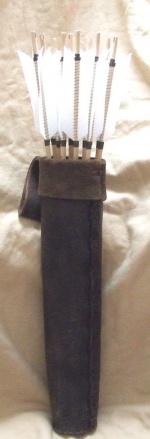Quiver: Difference between revisions
From Cunnan
Jump to navigationJump to search
(categorising) |
(links on picture description) |
||
| Line 1: | Line 1: | ||
[[image:Normanquiver.jpg|right|150px|thumb|11th Bayeux Tapestry quiver interpretation.]] |
[[image:Normanquiver.jpg|right|150px|thumb|[[11th century]] [[Bayeux Tapestry]] quiver interpretation.]] |
||
A '''quiver''' is a container for holding [[arrow]]s or [[bolt]]s. Generally of [[leather]] or [[wood]] and usually attached to a [[belt]] which is sometimes seen slung over the shoulder. Back quivers, however appear to be unknown from [[medieval]] [[Europe]]. |
A '''quiver''' is a container for holding [[arrow]]s or [[bolt]]s. Generally of [[leather]] or [[wood]] and usually attached to a [[belt]] which is sometimes seen slung over the shoulder. Back quivers, however appear to be unknown from [[medieval]] [[Europe]]. |
||
Examples of [[arrow]] quivers can be seen from [[Viking]] Age |
Examples of [[arrow]] quivers can be seen from [[Viking]] Age [[grave]]s and from later [[Norman]] depictions but they seem to remove themselves by the high [[medieval]] [[period]], at least in [[war]], to be replaced by [[arrow bag]]s. [[Crossbow]] quivers remain ubiquitous throughout the [[crossbow]]s existence. |
||
[[category:weapons]] |
[[category:weapons]] |
||
Latest revision as of 14:23, 13 October 2006
A quiver is a container for holding arrows or bolts. Generally of leather or wood and usually attached to a belt which is sometimes seen slung over the shoulder. Back quivers, however appear to be unknown from medieval Europe.
Examples of arrow quivers can be seen from Viking Age graves and from later Norman depictions but they seem to remove themselves by the high medieval period, at least in war, to be replaced by arrow bags. Crossbow quivers remain ubiquitous throughout the crossbows existence.
